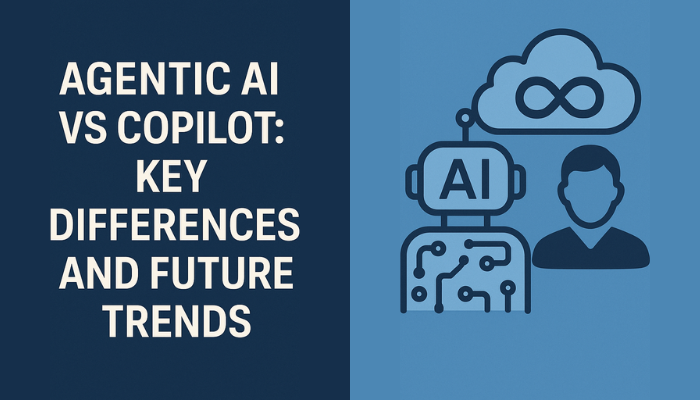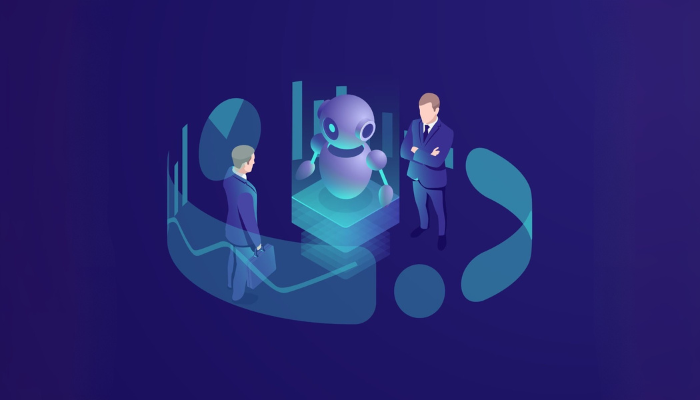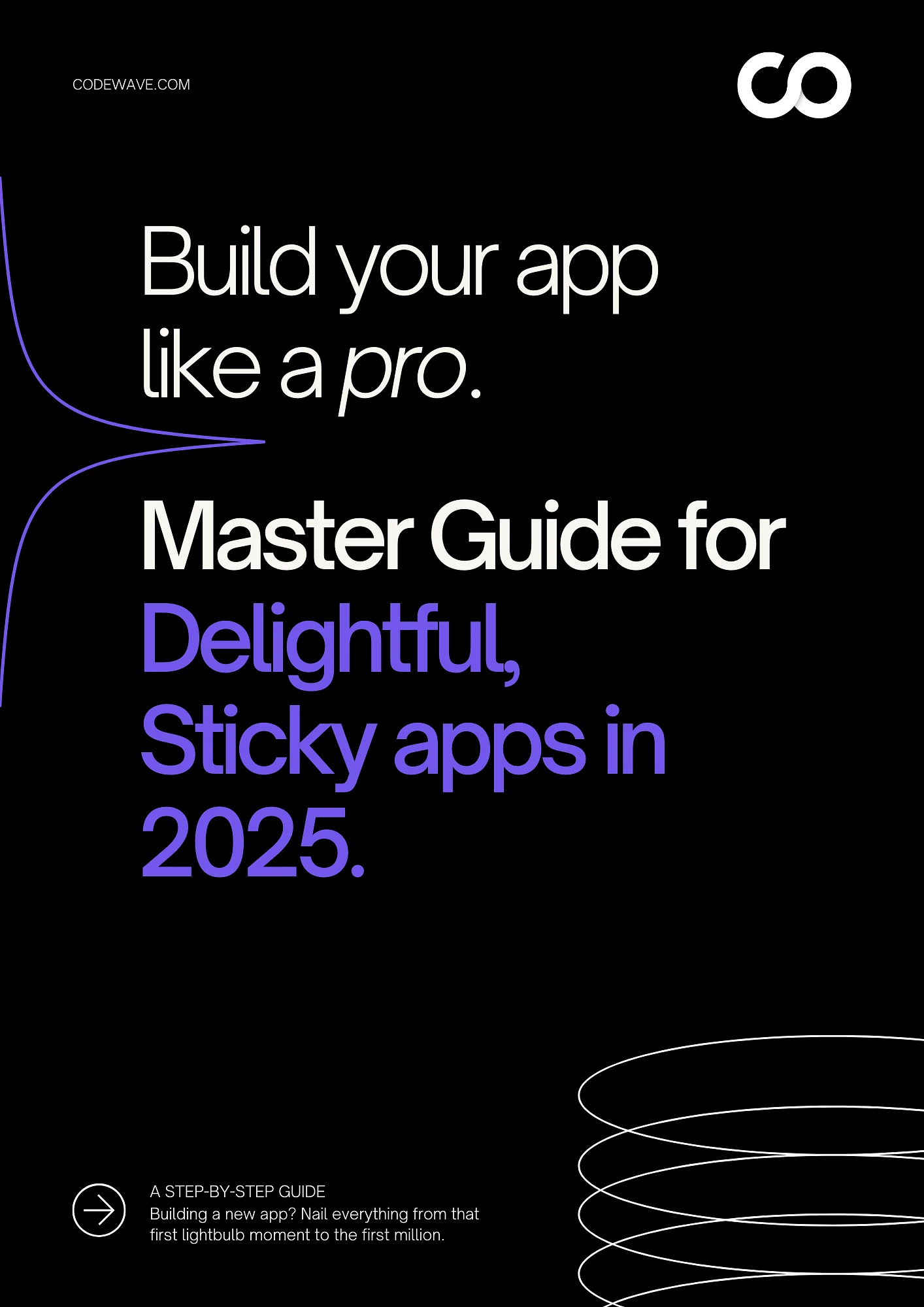If you’re exploring AI tools to enhance your business operations, you’ve probably come across terms like Agentic AI and AI Copilot. Agentic AI refers to autonomous systems capable of taking initiative, setting goals, and acting independently based on their understanding of a situation. AI Copilot, on the other hand, is a collaborative assistant designed to support humans by offering suggestions, automating tasks, or providing insights, while the human remains in control.
Both of these technologies are reshaping how businesses approach automation and decision-making, but they serve different purposes.
In this blog, we’ll explain the functions of Agentic AI and AI Copilot, highlight the key differences based on autonomy, goal orientation, decision making, and many more, share a quick comparison table, and provide use cases and examples.
Plus, we’ll discuss future trends. Whether you’re looking to implement AI or simply stay informed, this blog will help you understand the role of Agentic AI and AI Copilot today.
Defining Agentic AI and AI Copilot
As AI keeps evolving, two powerful tools are changing how businesses work: Agentic AI and AI Copilot. Here is the definition of both to help you understand their roles.
Agentic AI
Agentic AI refers to AI systems that operate autonomously, making decisions and taking actions without much human intervention. These systems can analyze data, predict outcomes, and carry out tasks independently, often improving efficiency and decision-making in business processes.
Key Features of Agentic AI
Agentic AI comes with smart features that help it work on its own, just like a real assistant. Here are some of the main things it can do:
- Autonomous Task Execution
Agentic AI doesn’t wait around for instructions. Once it understands your objectives, it makes decisions and takes action without needing constant supervision. For example, if you’re launching a marketing campaign, it can analyze data, generate content, and schedule posts automatically.
- Goal-Oriented Intelligence
Unlike traditional AI that reacts to prompts, Agentic AI works toward long-term outcomes. It can break down complex goals into smaller tasks, execute them in sequence, and adjust along the way. This makes it perfect for ongoing projects like lead nurturing, financial planning, or inventory management.
- Advanced Context Awareness
This AI understands your working environment, past interactions, preferences, and real-time updates. It adapts its actions based on the full context, making it smarter and more accurate with each use. So, if your priorities shift, it shifts with you.
- Multi-Step Planning and Reasoning
Agentic AI is built for complex logic. If you ask it to “plan a business trip,” it doesn’t just book a flight. It checks your schedule, finds the best routes, books hotels, adjusts for time zones, and even prepares an itinerary, without being prompted for each step.
- Learning Through Feedback Loops
This AI improves as it goes. It reviews past actions and outcomes to refine its approach. For instance, if it learns that you prefer morning meetings over afternoon ones, it starts scheduling accordingly.
- System and App Integration
Agentic AI connects with your email, CRM, project management tools, and calendars, allowing it to function across platforms seamlessly. This ensures a fluid experience where tasks don’t get stuck due to software barriers.
Benefits of Using Agentic AI
Using Agentic AI can make your work easier and save you a lot of time. Here are the main benefits it can help you:
- Significant Time Savings
By taking over routine or multi-step tasks, Agentic AI frees up your time so you can focus on strategy, creativity, or decision-making, not just daily operations.
- Improved Efficiency and Accuracy
You get more done with fewer mistakes. The AI follows consistent logic, double-checks data, and avoids the human errors that often come from multitasking or fatigue.
- Smart Decision-Making Without Micro-Management
Because it understands goals and context, it can make informed decisions in real time. This means you no longer have to babysit tasks or recheck every step.
- Personalized User Experience
Agentic AI learns your workflow, tone, and behavior, creating a highly personalized support system that feels like it was made just for you.
- Reliable, Scalable Support
As your needs grow, whether personal or professional, the AI grows with you. It can manage one project or fifty without slowing down or losing accuracy.
- Always Available and Evolving
Unlike human assistants, Agentic AI works 24/7 and keeps improving. It continuously adapts to changes in your data, preferences, and environment, becoming smarter over time.
Having covered what Agentic AI can do independently, let’s explore how AI Copilot assists you as you work.
AI Copilot
AI Copilot refers to a supportive tool that works alongside human users. It helps by providing suggestions, automating repetitive tasks, and assisting with decision-making, but still requires human input to guide the overall process.
Key Features of AI Copilot
AI Copilot is a helpful tool that supports you while you work. These are the key features that make it useful:
- Real-Time, Contextual Assistance
As you type, design, or code, the Copilot understands what you’re doing and offers immediate suggestions. For example, while writing an email, it may suggest a more professional tone or auto-fill common phrases.
- Natural Language Interaction
You can speak to your Copilot just like you would to a human. Ask it questions or give commands in plain English, and it understands exactly what you need, making it incredibly user-friendly.
- Tool-Specific Integration
Copilots are embedded into tools you already use, like Microsoft Word, Excel, GitHub, Notion, and Google Sheets. That means no need to switch apps or learn new software.
- On-Demand Automation
Whether it’s summarizing a report, drafting a response email, or generating a sales forecast, you can ask your Copilot to do it in seconds. It handles repetitive tasks so you don’t have to.
- Continuous Learning and Skill Enhancement
As you work, the Copilot not only assists but also helps you grow. It shows you better ways to structure a sentence, debug your code, or format a document, like having a real-time mentor.
- Transparent and Controllable Output
You always stay in control. The Copilot doesn’t act on its own; it presents suggestions that you can accept, reject, or edit. It’s collaborative, not authoritative.
Benefits of Using AI Copilot
AI Copilot makes your daily tasks faster and easier. Here is how it can benefit you:
- Enhanced Productivity
Your workflow speeds up significantly. With smart suggestions and one-click automation, you can complete tasks that used to take hours in just minutes.
- Reduced Mental Fatigue
The Copilot handles the small stuff, like checking grammar, formatting spreadsheets, or inserting citations, so your mind stays fresh for the big-picture work.
- Informed Decision-Making
The Copilot can pull in relevant data, highlight trends, or suggest options based on your context, helping you make better, faster decisions.
- Boosted Creativity
Whether you’re writing a report or designing a presentation, the Copilot throws in ideas, rephrases content, and suggests alternatives to keep your creativity flowing.
- Seamless Collaboration
By handling meeting notes, drafting messages, and managing follow-ups, it becomes an invaluable part of team communication and collaboration.
- Personal Growth Over Time
The more you use it, the more it aligns with your voice, style, and preferences, making it smarter and more effective in helping you evolve in your role.
Looking to build your own Agentic AI systems?
Our [Introductory Guide to Developing Agentic AI Systems Using Python] is here to help you get started.
Having defined what Agentic AI and AI Copilot are, let’s explore the key differences between Agentic AI and AI Copilot to help you see how they compare.
Key Differences Between Agentic AI vs Copilot
To fully understand the differences between Agentic AI and AI Copilot, it’s important to look at how these technologies work in real-world business environments. Both have their strengths, but they serve different purposes depending on the level of control, automation, and complexity your business requires.
Below are the key differences between these two AI systems to help you grasp how each one can make an impact on your business.
- Autonomy
Autonomy plays a crucial role in how each system operates. Here are the key differences in how autonomy affects their performance.
- Agentic AI
Agentic AI is designed to work independently. It can initiate tasks, make decisions, and adjust plans automatically without your input. This high level of autonomy makes it ideal for environments where efficiency and quick responses are essential, without the need for constant oversight.
Example: In a supply chain management system, Agentic AI could autonomously monitor inventory, track shipments, detect delays, and even reorder stock when levels get low. You don’t need to intervene in these processes unless a major issue arises. The system continuously manages and optimizes operations without requiring your daily involvement.
- Copilot
A Copilot, on the other hand, is designed to work alongside you. It’s like a helpful assistant that enhances your workflow by automating specific tasks or suggesting improvements. However, it doesn’t act without your explicit direction. It can’t initiate actions or make decisions on its own. You, as the user, remain in control throughout the process.
Example: In a customer service setting, a Copilot integrated into your Customer Relationship Management (CRM) system might suggest how to respond to a customer query based on past interactions. But, you still need to decide which response is the best. If the query involves something unique, such as a complex issue or a special offer, you are in control of how to proceed, and the Copilot just helps make your job easier.
- Goal Orientation
The way these technologies approach goal setting differs significantly. The following are the core differences in their goal orientation.
- Copilot
While Copilot can assist in achieving your goals, it doesn’t set the goals itself. Instead, it reacts to the objectives you set, helping you automate parts of the process and suggesting ways to make things more efficient. It doesn’t drive the direction; you do.
Example: In a marketing campaign, a Copilot might analyze past data and suggest target audiences or offer content recommendations. But, you, as the campaign manager, will still define the core goals of the campaign, such as increasing customer engagement or generating more sales.
- Agentic AI
Agentic AI, however, is fully goal-oriented on its own. It defines its own objectives, creates strategies to reach those objectives, and then executes the tasks necessary to achieve them. This proactive, goal-driven approach means that the AI handles complex processes without needing your continuous guidance.
Example: In a financial forecasting tool, Agentic AI might identify investment opportunities, set goals to achieve desired returns, and adjust portfolios to meet those goals. The AI continuously adjusts and evolves its plans based on market data and its own objectives, without waiting for human instructions.
- Decision-Making
How decisions are made is a fundamental aspect of both systems. Below are the key differences in their decision-making capabilities.
- Agentic AI
Agentic AI makes decisions on its own. It evaluates data, weighs the risks and benefits, and decides what actions to take. It doesn’t require your input to execute decisions; it simply acts based on the analysis it conducts.
Example: In a stock trading environment, Agentic AI might continuously analyze the market, adjust positions, and buy or sell assets to achieve the best financial outcomes. It does all of this in real-time, without waiting for any user approval, ensuring faster responses and maximized profit potential.
- Copilot
In contrast, the Copilot provides data-driven insights and suggests the best course of action based on the information it processes, but the final decision rests entirely with you. The Copilot can never make decisions independently; it’s more of a guide than a decision-maker.
Example: In a project management system, a Copilot can analyze task deadlines and suggest how resources should be allocated. However, you’re the one who makes the final call based on the project’s specific needs, your team’s capacity, and any other external factors.
- Reasoning and Problem-Solving
The way each system tackles problem-solving and reasoning can have a major impact on its functionality. Here are the primary differences in their problem-solving abilities.
- Agentic AI
Agentic AI has the ability to reason through complex scenarios. It can anticipate problems, come up with solutions, and take action based on its analysis of data and situations. It doesn’t wait for you to dictate what to do; it takes matters into its own hands, adjusting its approach as necessary.
Example: In logistics, Agentic AI might predict delays in a shipping route based on weather conditions, reroute shipments automatically, and reschedule deliveries. It adapts to new data in real-time, solving problems on the fly without the need for human intervention.
- Copilot
However, a Copilot typically works within a predefined set of rules and patterns it has learned. It can help solve problems that have well-established solutions but struggle when faced with unique or complex challenges. It can’t think ahead or adapt to new situations that don’t fit the established pattern.
Example: In a helpdesk scenario, a Copilot can solve common issues such as resetting passwords or troubleshooting simple technical problems. However, if a new, more complex issue arises, like a software bug that requires in-depth investigation, the Copilot would be of limited help, requiring you to step in.
- Learning and Adaptability
The ability to learn and adapt is vital for any AI system. The following are the distinctions between their learning and adaptability features.
- Agentic AI
Agentic AI continuously learns and adapts without needing explicit feedback. It learns from its actions, outcomes, and environmental changes, which allows it to evolve autonomously and adapt to new situations without your input.
Example: In healthcare, Agentic AI can analyze patient health data and adjust its recommendations without requiring feedback after each treatment. It continuously improves by learning from medical outcomes and new research, ensuring it provides the best care based on the latest data.
- Copilot
A Copilot improves its suggestions over time based on the feedback it receives from you. It adjusts to your preferences, but this requires continuous interaction. It learns from your behavior and refines its performance accordingly.
Example: A Copilot may suggest headline improvements or keyword changes in a content management tool based on your past preferences. The more you use it and provide feedback, the better it gets at aligning with your personal style.
- Interaction with the Environment
Each technology interacts with its environment in a unique way. Below are the key differences in how they engage with their surroundings.
- Agentic AI
Agentic AI integrates across multiple platforms, APIs, and systems. It connects and interacts with different tools and environments, creating a holistic workflow that spans multiple functions and departments.
Example: In a large retail operation, Agentic AI could integrate with inventory management, sales, marketing, and customer service systems to automate promotions, stock management, and personalized recommendations, all in real-time and across various platforms.
Want to see how AI agents are transforming retail and e-commerce?
Read our blog on [AI Agents Transforming Retail and E-Commerce] to find out more.
- Copilot
A Copilot, on the other hand, operates mainly within the system or software it is integrated into. It enhances specific tasks within that environment, helping to automate or streamline processes, but it doesn’t extend beyond the boundaries of the platform it’s designed for.
Example: A Copilot in an email marketing platform might help automate campaign scheduling, suggest email subject lines, and optimize content. However, it only works within the confines of that platform and doesn’t interact with other tools like your CRM or sales database.
- Use Cases
Both technologies have specific use cases where they excel. Here are the notable differences in their application areas.
- Agentic AI
Agentic AI excels in environments that require full autonomy, particularly for complex, multi-step processes where human intervention isn’t practical. It is ideal for systems that need real-time decision-making and continuous management.
Example: In autonomous driving, Agentic AI takes full control of the vehicle, making driving decisions, navigating through traffic, and adjusting speed based on real-time conditions, without any human involvement.
- Copilot
Copilot is best suited for tasks where you need assistance, but human oversight is still required. It’s great for environments where you need a supportive tool that helps with decision-making and process optimization.
Example: In software development, a Copilot can assist by recommending code optimizations, catching bugs, and suggesting efficient algorithms, but the developer must still make key design decisions, manage the project, and write the final code.
- Business Impact
The effect of these technologies on business operations is significant. The following are the primary ways they impact business outcomes.
- Agentic AI
Agentic AI can have a profound impact on business outcomes by enabling full-scale automation of complex tasks, reducing labor costs, improving scalability, and enhancing decision-making speed. It can drive significant operational changes and help businesses achieve more with less effort.
Example: In a finance company, Agentic AI could autonomously manage trading, analyze market trends, and make real-time investment decisions, all of which would streamline operations and significantly reduce the need for human labor in routine financial tasks.
- Copilot
A Copilot can boost productivity by automating repetitive tasks and providing recommendations to help you make decisions more quickly. It improves efficiency but doesn’t transform how business operations are run at a fundamental level.
Example: In customer service, a Copilot might automate the scheduling of support tickets, route inquiries to the right departments, and provide suggestions for responses. This helps improve efficiency but still requires human oversight for complex cases.
- Ethical and Control Considerations
Ethical concerns and control considerations are crucial in the deployment of AI. Below are the key differences in how each technology handles these concerns.
- Agentic AI
With Agentic AI, there are more ethical considerations, particularly because it operates independently. There is a need for clear governance and oversight to ensure its actions align with ethical standards and regulatory requirements, especially in sensitive areas like healthcare or finance.
Example: In healthcare, if Agentic AI autonomously adjusts treatment plans or recommends medical interventions, ensuring that these actions adhere to medical ethics and regulatory guidelines becomes critical, requiring a robust oversight system.
- Copilot
Since a Copilot works under your control, ethical concerns are minimal. You remain responsible for the actions taken, ensuring accountability for all decisions made through the tool.
Example: In a legal firm, while a Copilot might suggest changes to a contract or help with document review, the lawyer is responsible for ensuring the document’s legal validity and compliance with regulations.
- Technical Complexity and Implementation
Implementing these technologies can vary greatly in complexity. Here are the differences in their technical requirements and ease of implementation.
- Agentic AI
Implementing Agentic AI is far more complex. It requires sophisticated AI models, real-time data integration, and extensive infrastructure. The process involves more technical setup and ongoing management, which means businesses need to invest more in both time and resources.
Example: Deploying Agentic AI in a supply chain management system involves integrating multiple data sources, establishing machine learning algorithms, and setting up real-time monitoring to ensure the AI works effectively across various systems. This requires both technical expertise and substantial investment in AI infrastructure.
- Copilot
A Copilot is easy to implement and typically integrates seamlessly with existing tools and workflows. It doesn’t require major changes to your infrastructure and is user-friendly, making it an accessible solution for businesses with limited technical resources.
Example: In your project management system, adding a Copilot to automate task allocation or generate progress reports is simple. It works within the existing structure and doesn’t require complex integrations or high-level technical expertise.
Interested in the tools behind these technologies?
Head over to our blog on [The Top Agentic AI Frameworks and Tools] to learn more.
Now that you’ve grasped the main differences between Agentic AI and AI Copilot, it’s time to compare them directly. The table below will help you quickly visualize how each technology works.
Tabular Comparison of Agentic AI vs AI Copilot
To better understand the differences between Agentic AI and AI Copilot, the following table presents a quick comparison of their unique features.
| Aspect | Agentic AI | AI Copilot |
| Autonomy | Operates independently, initiates actions, and adjusts plans. | Requires user input to perform tasks. |
| Goal Orientation | Sets and executes its own goals. | Assists with user-defined goals. |
| Decision-Making | Makes decisions autonomously based on data. | Provides insights; the user makes the final decision. |
| Reasoning & Problem-Solving | Anticipates and adapts to complex issues independently. | Solves problems based on predefined patterns. |
| Learning & Adaptability | Continuously learns and evolves autonomously. | Learn from user feedback and interaction. |
| Interaction with Environment | Integrates across multiple systems and data sources. | Works within a specific platform or system. |
| Use Cases | Suitable for autonomous operations (e.g., IT management, autonomous vehicles). | Best for assisting with specific tasks (e.g., customer support, content creation). |
| Business Impact | Transforms operations by automating complex tasks. | Improves productivity by automating routine tasks. |
| Ethical & Control Considerations | Requires strong governance for ethical accountability. | Operates under human control with minimal ethical concerns. |
| Technical Complexity | Requires advanced infrastructure and integration. | Easy to implement with minimal technical expertise. |
Future Trends of Agentic AI and AI Copilot
The future of Agentic AI and AI Copilot is set to bring major changes. As these technologies keep improving, here’s what you can expect from their growing role:
- Increased Autonomy for Agentic AI
By 2028, it’s predicted that about 15% of daily work decisions will be made autonomously by Agentic AI, up from nearly 0% in 2024. This shift means AI will take on more responsibilities for planning, decision-making, and carrying out tasks without needing human involvement.
- AI Copilots as Everyday Helpers
AI Copilots will continue to serve as intelligent assistants, integrated into the apps you use daily, like Microsoft 365 or Teams. They’ll offer insights, suggestions, and support, but you’ll still make the final decisions before any actions are taken.
- Customization and Scalability
Tools like Microsoft’s Copilot Studio will allow businesses to easily customize and create AI agents tailored to their specific needs, even without extensive AI knowledge. This will help businesses adapt their AI tools to fit their workflows and scale them as they grow.
- Boosting Productivity and Creativity
Both Agentic AI and AI Copilots will enhance productivity by automating repetitive tasks and improving processes. This will free up your time to focus on more creative and strategic work. For example, tasks that once took weeks, such as risk analysis or customer onboarding, can now be completed in hours with AI.
- Integration Across Systems
Agentic AI will increasingly connect with a variety of external tools, APIs, and databases, allowing it to manage complex workflows across multiple platforms. This will help businesses handle growing amounts of data and operations more efficiently.
- Widespread Adoption
Well-known companies like Microsoft, Salesforce, and NVIDIA are investing heavily in these technologies, signaling that adopting AI Copilots and Agentic AI is becoming essential for staying competitive in today’s business landscape.
Maximize Your Business Efficiency with Codewave’s Agentic AI Solutions
At Codewave, we focus on creating Agentic AI solutions that help businesses automate processes, enhance decision-making, and boost operational efficiency. Our AI-powered solutions are built to reduce the need for constant human intervention, allowing your team to focus on more important tasks. We invite you to explore our work portfolio to see how our AI solutions have helped businesses just like yours drive innovation and growth.
Here is how our Agentic AI solutions can drive efficiency and growth in your business:
- Intelligent Decision-Making
Our intelligent agents can understand the context of tasks, make decisions independently, and perform complex multi-step actions, beyond what traditional automation can handle.
- This leads to faster and more accurate decision-making, improving overall business operations.
- Agentic Process Automation (APA)
By integrating APA, we go beyond typical automation.
- Our systems enable your agents to act autonomously, handling tasks from planning to execution without the need for constant human input, reducing delays and increasing productivity.
- Scalable & Flexible Architecture
Our solutions are built on a scalable, modular architecture, which means that as your business grows, so can the AI systems we provide.
- Whether you need to connect with CRM systems, Enterprise Resource Planning (ERP) software, or other tools, our Application Programming Interface (API)-driven components allow for seamless integration and real-time data synchronization across platforms.
- Continuous Learning & Improvement
What sets our Agentic AI apart is its ability to continuously learn from data and interactions.
- As it processes more information, it gets smarter over time, ensuring that automation becomes more efficient, accurate, and adaptable to your evolving business needs.
- Agentic AI Across Key Sectors
We develop Agentic AI solutions across various industries.
- Finance benefits from fraud detection, trading algorithms, and financial advisors.
- In retail, we create personalized shopping assistants and dynamic pricing tools.
- For energy, we optimize consumption and manage smart grids.
- In healthcare, we assist with diagnostics, scheduling, and patient monitoring.
- In education, we build personalized learning assistants and automated grading systems.
- In customer service, we provide 24/7 chatbots and intelligent routing.
Ready to see how Agentic AI can transform your business? [Book a demo slot], and get started today!
Codewave is a UX first design thinking & digital transformation services company, designing & engineering innovative mobile apps, cloud, & edge solutions.







